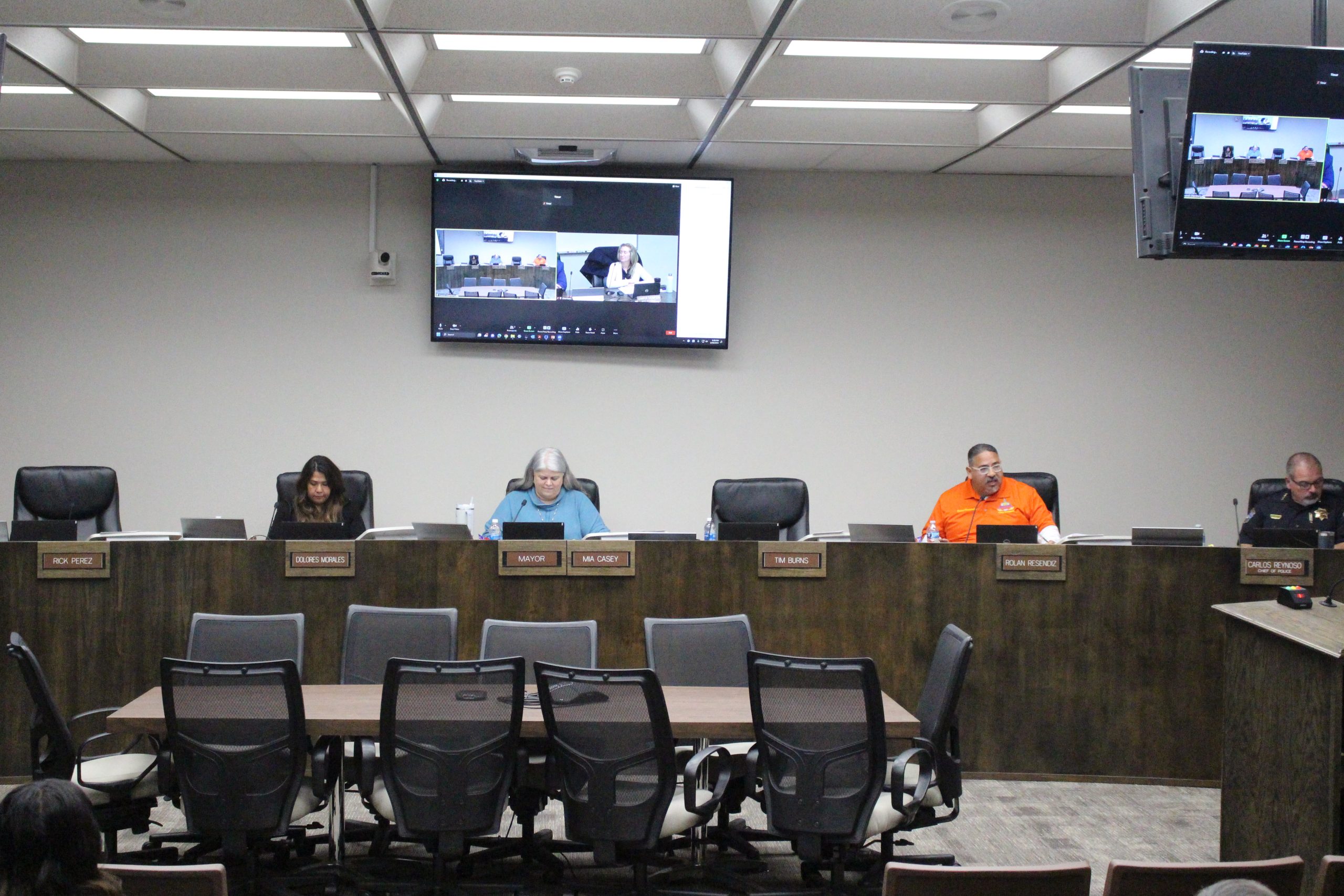Editor’s note: This article was updated to clarify the City Council’s decision on the stop signs. Lea este articulo en español aquí.
The Hollister City Council agreed to conduct a traffic study and consider road improvements along San Benito Street in response to concerns about speeding.
At its Feb. 20 meeting, the three present council members agreed to a traffic calming study to determine if four-way stops are needed along San Benito Street from Hawkins Street to Nash Road. Mark Falgout, a vice president with Kimley-Horn, the city’s engineering consultants, said the study will cost $60,634 and include vehicle speed data, online surveys and at least two public outreach meetings before coming back to the council for review.
In addition, the council agreed to conduct an initial traffic study to analyze adding four-way stops at the following intersections:
- Sunnyslope Road and Beverly Drive ($12,850)
- San Benito Street and Hawkins Street ($9,900)
- South Street and Sally Street ($9,900)
- Jan Avenue and Spring Drive ($9,900)
Cristian Builes, associate engineer with the city, said the engineering department received a petition from various residents about speeding on San Benito Street.
“However, as I stated before, according to the study that was done a couple of years ago, it didn’t seem that there was actually speeding on San Benito,” Builes said.
Falgout said the results of a traffic study conducted two years ago at Hawkins Street didn’t meet requirements to install traffic calming measures.
But the study did find there were not enough speed limit signs in town, Builes said. He added the engineering department is working to install additional signs—including speed feedback signs that show the current speed of the driver—along San Benito Street.
Builes said city staff was not recommending the traffic calming study on San Benito Street at this time, because of needed infrastructure repairs to the waterline and the sewer line. The most recent waterline break occurred on Feb. 10 between Hawkins and Haydon streets.
” data-medium-file=”https://i0.wp.com/benitolink.com/wp-content/uploads/2024/02/SanBenitoStWaterMainBreak-6-scaled.jpg?fit=300%2C200&ssl=1″ data-large-file=”https://i0.wp.com/benitolink.com/wp-content/uploads/2024/02/SanBenitoStWaterMainBreak-6-scaled.jpg?fit=780%2C520&ssl=1″ src=”https://i0.wp.com/benitolink.com/wp-content/uploads/2024/02/SanBenitoStWaterMainBreak-6.jpg?resize=780%2C520&ssl=1″ alt=”Water main break on San Benito Street on Feb. 10, 2024 around 1 a.m. Photo by Chris Mora. ” class=”wp-image-96480″ srcset=”https://i0.wp.com/benitolink.com/wp-content/uploads/2024/02/SanBenitoStWaterMainBreak-6-scaled.jpg?resize=1024%2C683&ssl=1 1024w, https://i0.wp.com/benitolink.com/wp-content/uploads/2024/02/SanBenitoStWaterMainBreak-6-scaled.jpg?resize=300%2C200&ssl=1 300w, https://i0.wp.com/benitolink.com/wp-content/uploads/2024/02/SanBenitoStWaterMainBreak-6-scaled.jpg?resize=768%2C512&ssl=1 768w, https://i0.wp.com/benitolink.com/wp-content/uploads/2024/02/SanBenitoStWaterMainBreak-6-scaled.jpg?resize=1536%2C1024&ssl=1 1536w, https://i0.wp.com/benitolink.com/wp-content/uploads/2024/02/SanBenitoStWaterMainBreak-6-scaled.jpg?resize=2048%2C1365&ssl=1 2048w, https://i0.wp.com/benitolink.com/wp-content/uploads/2024/02/SanBenitoStWaterMainBreak-6-scaled.jpg?resize=1200%2C800&ssl=1 1200w, https://i0.wp.com/benitolink.com/wp-content/uploads/2024/02/SanBenitoStWaterMainBreak-6-scaled.jpg?resize=1568%2C1045&ssl=1 1568w, https://i0.wp.com/benitolink.com/wp-content/uploads/2024/02/SanBenitoStWaterMainBreak-6-scaled.jpg?resize=400%2C267&ssl=1 400w, https://i0.wp.com/benitolink.com/wp-content/uploads/2024/02/SanBenitoStWaterMainBreak-6-scaled.jpg?resize=706%2C471&ssl=1 706w, https://i0.wp.com/benitolink.com/wp-content/uploads/2024/02/SanBenitoStWaterMainBreak-6-scaled.jpg?w=2340&ssl=1 2340w, https://i0.wp.com/benitolink.com/wp-content/uploads/2024/02/SanBenitoStWaterMainBreak-6-1024×683.jpg?w=370&ssl=1 370w” sizes=”(max-width: 780px) 100vw, 780px”>
“There’s a lot of issues with drainage at some of the intersections,” Builes said. “So rather than moving forward with some type of traffic calming, which we’re required to do surface improvements to see, we’d like to wait until later on, so that we can put together a product that will update the infrastructure and then see if there’s any traffic calming.”
Councilmembers Dolores Morales and Rolan Resendiz were on board to conduct the study. Mayor Mia Casey was not initially supportive, citing the infrastructure issues, but in the end agreed the study was needed.
Councilmembers Rick Perez and Tim Burns were absent.
Casey, Morales and Resendiz said they all received calls from residents about speeding in town.
“I’ve walked both sides of that street and I can tell you every single resident that lives on the street would tell you that our No. 1 priority is speeding,” Morales said about San Benito Street.
Resendiz said the city should work with residents to create solutions for the traffic problems after the study is conducted.
“I think we have to do the study now,” Resendiz said. “Then we can look at how we can creatively work together in partnerships with the residents to mitigate some of the things that they’re saying.”
There was no public comment.
Since the item was informational, the council did not need to vote. All council members verbally agreed to implement the four-way stops and conduct the traffic calming study along San Benito Street.
We need your help. Support local, nonprofit news! BenitoLink is a nonprofit news website that reports on San Benito County. Our team is committed to this community and providing essential, accurate information to our fellow residents. It is expensive to produce local news and community support is what keeps the news flowing. Please consider supporting BenitoLink, San Benito County’s public service, nonprofit news.

